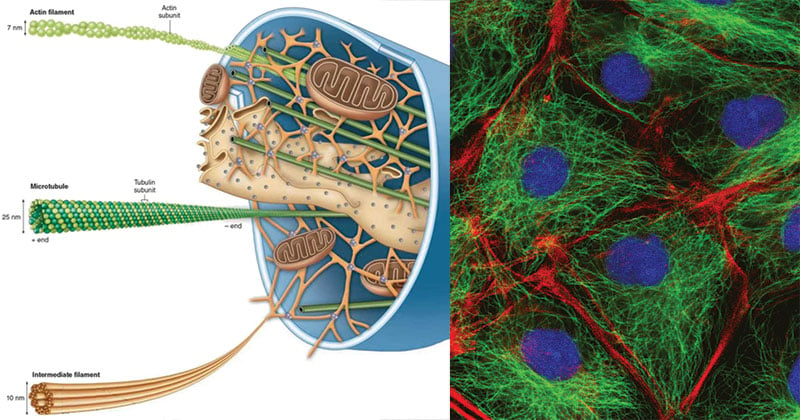Interesting Science Videos
Cytoskeleton Definition
- The cytosol of cells contains fibers that help to maintain cell shape and mobility and that probably provide anchoring points for the other cellular structures.
- Collectively, these fibers are termed as the cytoskeleton.
- The cytoskeleton gives cells structure and shape and allows them to move around. It’s also important for intracellular transport.
- At least three general classes of such fibers have been identified in eukaryotic cells. Each of these filaments is a polymer.
- All three filament systems are highly dynamic, altering their organization in response to the needs of the cell.

Figure: Diagram of Cytoskeleton
A. Microtubules
- The thickest are the microtubules (20 nm in diameter) which consist primarily of the tubulin protein.
- Each tubulin subunit is made up of one alpha and one beta-tubulin that are attached to each other, so technically tubulin is a heterodimer, not a monomer. Since it looks like a tube, it is named as microtubule.
- In a microtubule structure, tubulin monomers are linked both at their ends and along their sides (laterally). This means that microtubules are quite stable along their lengths.
- Since the tubulin subunits are always linked in the same direction, microtubules have two distinct ends, called the plus (+) and minus (-) ends.
- On the minus end, alpha-tubulin is exposed, and on the plus end, beta-tubulin is exposed.
- Microtubules preferentially assemble and disassemble at their plus ends.
Functions
- Transportation of water, ions or small molecules.
- Cytoplasmic streaming (cyclosis).
- Formation of fibers or asters of the mitotic or meiotic spindle during cell division.
- Formation of the structural units of the centrioles, basal granules, cilia, and flagella.
B. Microfilaments
- The thinnest are the microfilaments (7 nm in diameter) which are solid and are principally made of two intertwined strands of a globular protein called actin. For this reason, microfilaments are also known as actin filaments.
- Actin is powered by ATP to assemble its filamentous form, which serves as a track for the movement of a motor protein called myosin.
- This enables actin to engage in cellular events requiring motion such as cell division in animal cells and cytoplasmic streaming, which is the circular movement of the cell cytoplasm in plant cells.
Functions
- They maintain the shape of the cell.
- Form contractile component of cells, mainly of the muscle cells.
- White blood cells can move to the site of an infection and engulf the pathogen due to microfilaments.
C. Intermediate Filaments
- The fibers of the middle-order are called the intermediate filaments (IFs) having a diameter of 10 nm.
- They are composed of a family of related proteins sharing common structural and sequence features.
- They having been classified according to their constituent protein such as desmin filaments, keratin filaments, neurofilaments, vimentin, and glial filaments.
Functions
- Intermediate filaments contribute to cellular structural elements and are often crucial in holding together tissues like skin.
D. Microtrabecular Lattice
Recently, cytoplasm has been found to be filled with a three-dimensional network of interlinked filaments of cytoskeletal fibers, called a micro-trabecular lattice. Various cellular organelles such as ribosomes, lysosomes, etc., are found anchored to this lattice. The micro-trabecular lattice being flexible changes its shape and results in the change of cell shape during cell movement.
Functions of Cytoskeleton
The cytoskeleton is responsible for lots of important cellular functions:
- In animal cells, which lack a rigid cell wall, it is the cytoskeleton that determines cell shape.
- It allows cells to move.
- Engulf particles.
- Brace themselves against pulling forces.
- Transport vesicles through the cytosol.
- Separate chromosomes during cell division.
- It allows our muscles to contract.
References
- Verma, P. S., & Agrawal, V. K. (2006). Cell Biology, Genetics, Molecular Biology, Evolution & Ecology (1 ed.). S .Chand and company Ltd.
- Stephen R. Bolsover, Elizabeth A. Shephard, Hugh A. White, Jeremy S. Hyams (2011). Cell Biology: A short Course (3 ed.).Hoboken,NJ: John Wiley and Sons.
- Alberts, B. (2004). Essential cell biology. New York, NY: Garland Science Pub.
- https://study.com/academy/lesson/microtubules-definition-functions-structure.html
- https://courses.lumenlearning.com/boundless-biology/chapter/the-cytoskeleton/

Useful
under heading cytoskeleton definition, you mention three general classes of fibers that have been identified in eukaryotic cells. What are these classes? can you elaborate more?